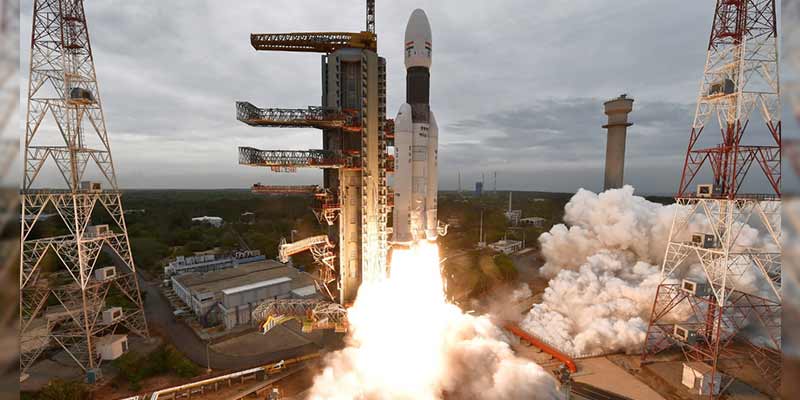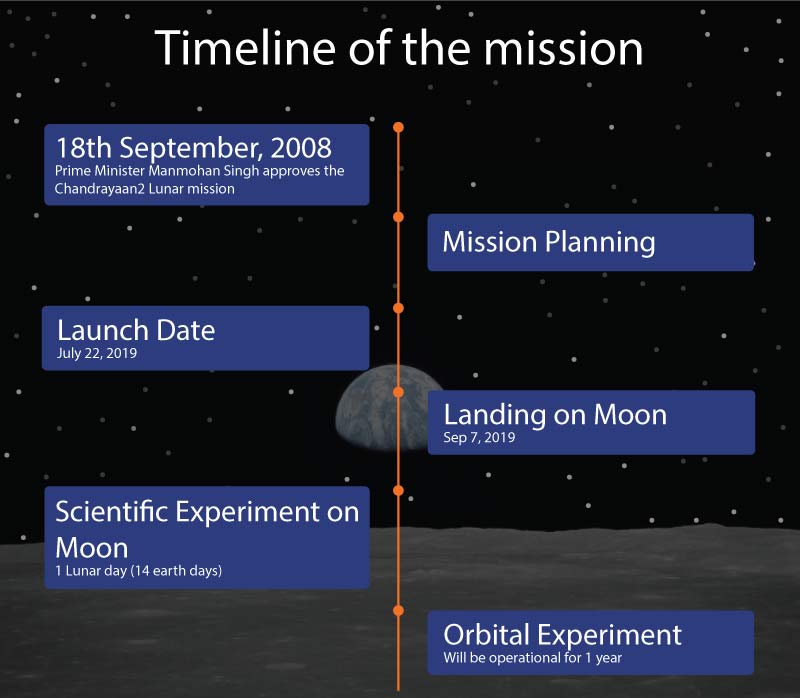- India
- Jul 22
India begins historic trip to the moon
India successfully launched its second moon mission Chandrayaan-2 on July 22 from its most powerful rocket with a plan to land the rover on September 7 in the unexplored lunar south pole.
The towering geosynchronous satellite launch vehicle GSLV-MkIII-M1 lifted off from the second launchpad at the spaceport into cloudy skies at 2.43 pm and successfully placed the 3,850-kg Chandrayaan-2 into the earth orbit about 16 minutes later.
The Rs 978 crore unmanned mission also brought woman power to the fore as it was helmed by two female scientists of ISRO - Ritu Karidhal and M. Vanitha, the mission and project directors, respectively.
The most complex and prestigious mission ever undertaken by ISRO, if successful, will also make India the fourth country after Russia, the US and China to pull off a soft landing on the moon.
“We bounced back with flying colours after the earlier technical snag. Success is coming after a call off,” said a visibly relieved ISRO chairman K. Sivan at the mission control room of the Satish Dhawan Space Centre in Sriharikota.
Immediately after Chandrayaan-2’s separation from the rocket, the solar array of the spacecraft automatically got deployed and the ISRO Telemetry, Tracking and Command Network at Bengaluru successfully took control of the spacecraft, ISRO said.
According to ISRO, the lunar south pole is an interesting surface area that remains in shadow than the north pole. There is a possibility of the presence of water in permanently shadowed areas around it, the agency said, adding craters in the south pole region have cold traps and contain fossil record of the early solar system.
What happens next?
Chandrayaan-2 will be subjected to a series of orbit manoeuvres using its onboard propulsion system to take it to the vicinity of the moon over the next few weeks with the rover soft landing planned on September 7.
At the end of the Earth-bound phase, the orbit of the spacecraft will be finally raised to over 1.05 lakh km before nudging it into the Lunar Transfer Trajectory taking it to the proximity of the moon in the next few days.
Then gradually over the next few days it will be brought to 100x100 km circular orbit when the lander Vikram carrying rover Pragyan will separate and after another few days of orbiting it will make a soft landing at a chosen place on the lunar surface.
The three modules
The spacecraft has three modules - orbiter, lander (Vikram) and rover (Pragyan).
The integrated module would reach the moon’s orbit using the orbiter propulsion module and subsequently, the lander would separate from the orbiter and soft land at the predetermined site, close to the lunar south pole, and deploy the rover.
The rover would roll out for carrying out scientific experiments on the lunar surface. ISRO said instruments were also mounted on the lander and orbiter for carrying out scientific experiments.
Orbiter: The orbiter will be capable of communicating with Indian Deep Space Network (IDSN) at Byalalu near Bengaluru as well as the lander. The mission life of the orbiter is one year and it will be placed in a 100x100 km lunar polar orbit.
Lander: It is named after Vikram Sarabhai, the father of the Indian space programme. It is designed to function for one lunar day, which is equivalent to about 14 Earth days. Vikram has the capability to communicate with IDSN, as well as with the orbiter and rover. The lander is designed to execute a soft landing on the lunar surface.
Rover: It is a six-wheeled robotic vehicle named Pragyan, which translates to ‘wisdom’ in Sanskrit. It can travel up to 500m and leverage solar energy for its functioning. It can only communicate with the lander. It will take four hours for the rover to come out to the surface after the lander makes a touchdown.
The lander and rover will have the mission life of 1 lunar day (14 Earth days) and the day of landing (September 7) will be the beginning of lunar day. “For one lunar day this lander and rover will be functioning and carry out scientific experiments,” Sivan said.
The mission objective of Chandrayaan-2 is to develop and demonstrate the key technologies for end-to-end lunar mission capability, including soft-landing and roving on the lunar surface. On the science front, this mission aims to further expand our knowledge about the moon through a detailed study of its topography, mineralogy, surface chemical composition, thermo-physical characteristics and atmosphere leading to a better understanding of the origin and evolution of the moon.
Chandrayaan-2 has several science payloads to facilitate a more detailed understanding of the origin and evolution of the moon. The orbiter carries eight payloads, the lander carries three, and the rover carries two. Also, a passive experiment is included on the lander. The orbiter payloads will conduct remote-sensing observations from a 100 km orbit while the lander and rover payloads will perform in-situ measurements near the landing site.
Chandrayaan-2 comes 11 years after ISRO’s successful first lunar mission Chandrayaan-1, which scripted history by making more than 3,400 orbits around the moon and was operational for 312 days till August 29, 2009.


